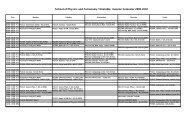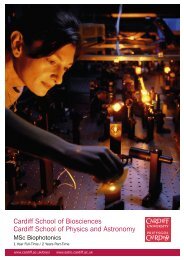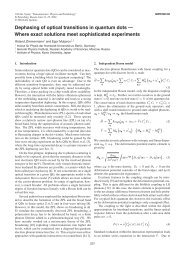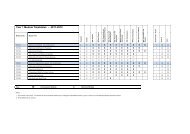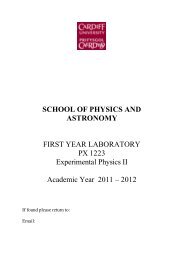PX1121 MECHANICS AND MATTER - Cardiff School of Physics and ...
PX1121 MECHANICS AND MATTER - Cardiff School of Physics and ...
PX1121 MECHANICS AND MATTER - Cardiff School of Physics and ...
You also want an ePaper? Increase the reach of your titles
YUMPU automatically turns print PDFs into web optimized ePapers that Google loves.
PX1221 ELECTRICITY, MAGNETISM <strong>AND</strong> WAVES<br />
MODULE INFORMATION:<br />
Spring semester: 20 credits.<br />
Module organiser: Dr J I Davies.<br />
Deputy Module Organiser: Pr<strong>of</strong> P Coles.<br />
Teaching methods: 44 contact hours including lectures, weekly exercises <strong>and</strong> problem-solving sessions. Feedback: weekly<br />
marked exercises <strong>and</strong> tutorials.<br />
Assessment: Examination 60%. Coursework 40%. [Examination duration: 3 hours]<br />
Pre-cursors: PX1122 (excepting joint Maths/<strong>Physics</strong> students).<br />
Co-requisites: PX1222 (excepting joint Maths/<strong>Physics</strong> students).<br />
Pre-requisites: None.<br />
AIMS OF THE MODULE:<br />
To introduce the mathematical language <strong>of</strong> waves to describe wave formation, wave propagation <strong>and</strong> interference <strong>and</strong><br />
diffraction.<br />
To examine matter at an atomic level to give insight into crystal bonding <strong>and</strong> the electrical, thermal <strong>and</strong> mechanical<br />
properties <strong>of</strong> matter.<br />
To introduce concepts <strong>of</strong> electrostatics, <strong>of</strong> magnetic fields associated with currents <strong>and</strong> <strong>of</strong> electromagnetic induction to<br />
provide a firm foundation for the study <strong>of</strong> electromagnetism in Year 2.<br />
To provide insight into forced vibration <strong>and</strong> resonance through examples <strong>of</strong> AC theory <strong>and</strong> mechanical analogues.<br />
To give instruction <strong>and</strong> practice in solving physics problem.<br />
LEARNING OUTCOMES:<br />
The student will be able to:<br />
Distinguish between different wave types <strong>and</strong> describe wave <strong>and</strong> energy propagation mathematically in one or more<br />
dimensions.<br />
Apply boundary conditions to wave equations to determine the formation <strong>of</strong> st<strong>and</strong>ing waves in strings <strong>and</strong> pipes <strong>and</strong><br />
explain refraction.<br />
Demonstrate an underst<strong>and</strong>ing <strong>of</strong> interference <strong>and</strong> diffraction, including crystal diffraction.<br />
Describe the distinguishing features between conductors, insulators <strong>and</strong> semiconductors.<br />
Discuss phase changes in matter.<br />
Describe the origin <strong>and</strong> nature <strong>of</strong> the various forces <strong>and</strong> fields associated with static <strong>and</strong> moving charges.<br />
Recall the basic laws <strong>of</strong> electromagnetism <strong>and</strong> use integration methods to apply Coulomb’s law <strong>and</strong> the Biot-Savart law to<br />
complex systems <strong>of</strong> charges or circuits.<br />
Derive basic equations for free <strong>and</strong> forced oscillations <strong>of</strong> damped electrical <strong>and</strong> mechanical systems using both real <strong>and</strong><br />
complex notation.<br />
OUTLINE SYLLABUS:<br />
1. Waves: Classification <strong>of</strong> waves. One-dimensional non-dispersive waves. D’Alembert’s solution. Harmonic waves.<br />
Derivation <strong>of</strong> the wave equation for transverse waves on a string. Energy density <strong>and</strong> power flow in a travelling wave.<br />
2. Refraction <strong>and</strong> dispersion: Plane waves at boundaries. Refraction <strong>and</strong> Snell’s laws. Refracting optics. Dispersion.<br />
3. Superposition: Beats. Longitudinal waves in solids <strong>and</strong> sound waves. Sound intensity. Spherical waves <strong>and</strong> the inverse<br />
square law. St<strong>and</strong>ing waves. Interference <strong>and</strong> diffraction. Examples.<br />
4. Waves <strong>and</strong> matter: Light interaction with matter <strong>and</strong> elementary spectroscopy (Bohr theory). Diffraction studies <strong>of</strong><br />
solids, leading to atoms, bonding <strong>and</strong> crystal structure.<br />
5. Electronic properties <strong>of</strong> matter: Electrical properties <strong>of</strong> materials – conductors, insulators <strong>and</strong> semiconductors. Free<br />
electrons, energy b<strong>and</strong>s <strong>and</strong> b<strong>and</strong> gaps. Semiconductor doping <strong>and</strong> the p-n junction.<br />
6. Coulomb’s <strong>and</strong> Gauss’s Laws: Electric charge <strong>and</strong> Coulomb’s law. E <strong>and</strong> V fields. Field lines <strong>and</strong> forces. Electric flux.<br />
Gauss’ law. Examples <strong>of</strong> charge distributions, including sphere <strong>and</strong> line.<br />
7. Capacitance: Electric potential, potential difference, relationship between E <strong>and</strong> V. Electric energy <strong>and</strong> energy density.<br />
Capacitance. Dielectrics. Energy stored on a capacitor. Capacitance <strong>of</strong> sphere <strong>and</strong> coaxial cable.<br />
8. Electricity <strong>and</strong> magnetism: Conductivity, resistivity <strong>and</strong> resistance. Electrical power. Magnetic effects <strong>of</strong> current-carrying<br />
wires. Magnetic field lines, flux <strong>and</strong> Lorenz force. Biot-Savart law <strong>and</strong> applications. Torque on a current loop.<br />
9. Electromagnetic induction: Faraday’s law <strong>and</strong> electromagnetic induction. Mutual <strong>and</strong> self inductance. Inductors.<br />
10. AC Theory: Circuit elements: R, C <strong>and</strong> L. RMS. Power factors. LCR circuits. Rotating vector <strong>and</strong> complex-exponential<br />
representation. Phasor diagrams.<br />
11. Resonance: Damped free vibrations. Light, heavy <strong>and</strong> critical damping. Quality factor. Forced vibration. Response<br />
functions: displacement amplitude <strong>and</strong> phase as a function <strong>of</strong> frequency. Absorbed power. Steady-state <strong>and</strong> transient<br />
solutions. Electrical <strong>and</strong> mechanical analogues.<br />
TRANSFERABLE SKILLS:<br />
Mathematics. Problem solving. Investigative skills. Analytical skills.



